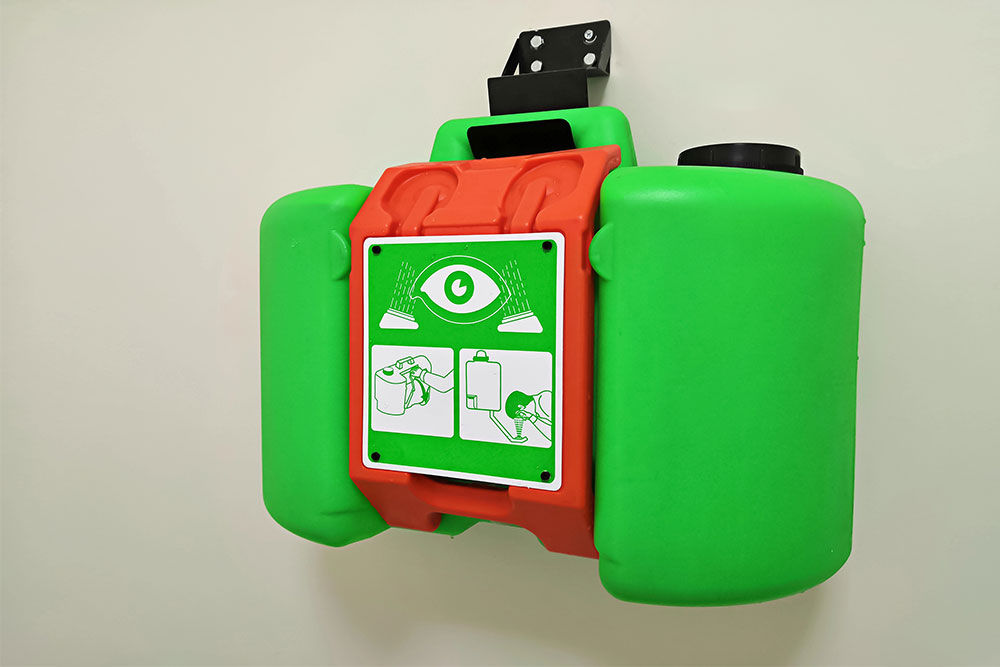 27
Mar
27
Mar
Creating An Effective Eyewash Station Inspection Checklist
- 0 Comment(s)
- March 27, 2025
Eyewash station inspection is vital for maintaining a safe and compliant work environment. Regular checks can prevent accidents and confirm that emergency eyewash stations are fully operational when needed. A well-structured checklist can help streamline this process and keep your equipment up to safety standards.
Why Eyewash Station Inspections Are Important
Eyewash stations are necessary in workplaces where employees are exposed to hazardous materials. These stations must always be ready to function in case of an emergency.
A quick, efficient inspection routine is key to guaranteeing these systems work when needed. An eyewash station checklist helps reduce downtime, comply with regulations, and increase safety.
The Occupational Safety and Health Administration (OSHA) requires that eyewash stations be properly maintained to safeguard employees working with harmful chemicals. Regular inspections reduce the risk of equipment failure during an important moment. They also help make sure businesses remain compliant with safety regulations.
Key Elements of an Eyewash Station Inspection Checklist
Location and Accessibility
The first step in any inspection is to assure the eyewash station is easily accessible. It should be located within a 10-second walk from hazardous areas. The path to the station must be clear of obstacles. It is also important to verify that the eyewash station is not blocked by equipment, furniture, or other materials.
An eyewash station should be clearly visible and free from obstructions to guarantee quick access in an emergency. Frequent checks of accessibility can help eliminate potential hazards like clutter. This can hinder employees from reaching the station when they need it most.
Water Flow and Temperature
The water flow should be steady and sufficient to flush out contaminants effectively. The water temperature is also important. Water should be tepid, between 60°F and 100°F. Water that is too cold or too hot can cause additional injuries or discomfort–possibly hindering the effectiveness of the eyewash.
Regular testing of the water temperature and flow guarantees the eyewash station functions optimally. If water is too hot or cold, it can worsen eye injuries or lead to further damage. This part of the inspection is important to help keep your station ready for use in any situation.
Water Pressure
Check the water pressure to make sure it meets the recommended standards. It should be strong enough to wash contaminants from the eyes, but not so powerful that it causes further injury. The pressure should be consistent and adjustable if necessary.
Consistent water pressure is necessary to flush debris or chemicals from the eyes effectively. Check if the pressure level remains optimal. Conduct regular checks to confirm that the water flow does not fluctuate over time.
Condition of the Eyewash Nozzles
Examine the eyewash nozzles for any damage or blockage. They should be free from debris. The flow should be smooth and consistent. Nozzles must also be positioned to direct water into both eyes simultaneously. If the nozzles are dirty or damaged, they may not function as intended during an emergency.
Check the nozzles for any buildup, corrosion, or defects that might affect their operation. The nozzles should be easy to adjust, with an even water flow to both eyes.
Cleaning and Maintenance
It is important to regularly clean the eyewash station to avoid contamination. Dust, debris, or stagnant water can make the station ineffective. This part of the inspection includes flushing the station to clear out any sediment or buildup. A quick flush once a week is recommended. A full inspection should be conducted monthly.
A maintenance schedule is key to keeping the station clean and free from impurities. In addition to flushing the station regularly, it is important to check and clean the pipes and water sources feeding the eyewash.
Neglecting these tasks can lead to equipment malfunction, especially if contaminated water gets into the system.
Visibility and Signage
Eyewash stations should be clearly marked and visible in the workplace. Guarantee there are appropriate signs indicating the location of the eyewash station.
These signs should be placed in high-traffic areas and be easily readable. Regular checks of signage help confirm that it has not been damaged or obstructed.
Signs should always be well-lit and clearly visible. Over time, signage can fade, or accidental damage can occur. Inspecting the condition of these signs makes sure that employees can quickly locate the eyewash station when needed.
Training and Readiness
Have employees familiar with the location and proper use of the eyewash station. Providing training on how to use the eyewash station is important to its effectiveness during an emergency. Periodically reviewing safety procedures and holding practice drills will help maintain readiness.
When workers know how to use an eyewash station correctly, they can respond faster in an emergency. This can help reduce injury severity and even prevent further damage to the eyes.
Frequency of Inspections
Regular inspections are necessary to keep eyewash stations functional. At a minimum, these checks should be done monthly, though more frequent checks are recommended in high-risk environments. Keep a record of all inspections to track any issues and verify that they have been resolved promptly.
An eyewash station inspection log is a valuable tool for tracking maintenance schedules, documenting any findings, and ensuring that nothing is overlooked. Be sure your team records every inspection and repair so that nothing slips through the cracks.
The Role of Eyewash Stations in Workplace Safety
Eyewash stations are a key component of overall workplace safety, especially in environments where employees handle hazardous chemicals or substances. Inspection and maintenance of these stations help comply with safety standards, prevent accidents, and protect your employees from potential harm.
In addition to eyewash stations, other safety measures like fire extinguishers and emergency lights play a significant role in the overall safety system of the workplace. These systems should also be inspected regularly to make sure that everything is functioning as it should.
Consistently maintaining all these features creates a safer environment for employees. This helps avoid accidents and minimize risks.
Compliance with OSHA Regulations
OSHA (Occupational Safety and Health Administration) requires employers to maintain eyewash stations in areas where employees may be exposed to hazardous chemicals.
The regulations specify that eyewash stations should meet certain requirements for accessibility, water temperature, and flushing capabilities. Businesses can maintain compliance and avoid penalties by conducting regular inspections.
Failing to comply with OSHA’s eyewash station regulations can lead to serious penalties or fines. Staying ahead of inspections and maintenance is a proactive way to prevent compliance issues and keep your workplace safe.
Yadkin Fire & Safety’s Commitment to Safety
Yadkin Fire & Safety understands the importance of maintaining all types of emergency safety equipment. Our team offers comprehensive fire safety services, including fire extinguisher inspections and maintenance.
We are committed to helping businesses keep their workplaces safe with timely service and expert support. Our quick turnaround on cylinder services makes sure that you are never left waiting when you need safety equipment ready to go.

